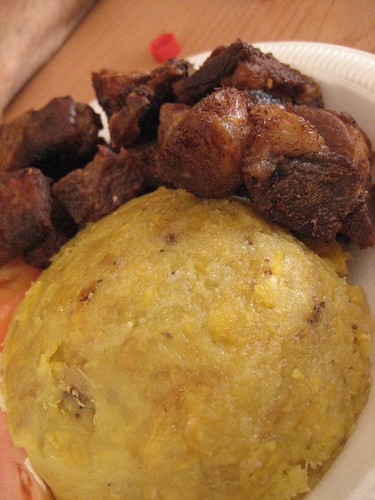
Hello Nom Folk,
Today I'd like to take a few minutes and type up a note to introduce you to one of my favorite instruments to use in my kitchen when it's cooking time. That picture above, is my very own, very old, ever-faithful Pilón (Pee-lohn).
Who would've thought that a primitive mechanism such as putting something between two rocks and using the friction between them to grind it, would develop into multiple uses in all cultures. It is used in a variety of materials, from ceramics and marble for pharmaceutical and botanical means...to the molcajete made out of stone, which is used widely in Mexico to grind down corn, make guacamole and salsas.
The "El Pilón y la maceta", or what is a Puerto Rican's version of a mortar and pestle, is made of solid wood and comes in a variety of sizes. It is the staple of our Caribbean cuisine and is almost considered a rite of passage for cooks to prove themselves masters of the kitchen. Ideally, one receives a pilón as a hand me down from our expert grandmother cooks or as a very appropriate wedding gift, signifying that it is now your turn to carry the torch when it comes to feeding your own family. Time to put your skills to use and break in that brand new pilón, ensuring it looks worn out and it carries battle scars of it's own. Stories to share with your own offspring as you show them how to properly machacar or grind down your ingredients.
As far as the pilón's beginnings in Puerto Rico, there are several accounts from Spanish soldiers dictating that upon arriving on our island, they witnessed devices similar to our pilones being used by the native indians (Taínos) to mash foods down to a pulp or fine powder. As time went by, bigger pilones emerged in the island's coffee plantations, which were used to process the dried coffee beans and grind them for distribution. Below is an image of two hacienda (coffee plantation) workers, using giant pilones to grind coffee beans - circa 1916:

Traditionally, my great grandmother did not only show me how to grind coffee beans from her back yard into a small pilón before brewing, but it is in this bowl that we also learned to make the base garlic paste which we use to season our meats, poultry, fish and veggies. It might not sound like a great deal, but trust me, your skill is demonstrated by being able to puree several cloves with a touch of olive oil and spices - without any cloves bouncing out as you slam down the maceta full force in small circles and all the bits perfectly turned into mush, with no lumps. Try it, then get back to me. That mixture is then either rubbed on your choice of meat or throw on a skillet in preparation of other foods. The holy base of cooking.
Not to forget, the pilón is also the home where one puts in one of our ultimate traditional dishes. The mofongo. The mofongo comes to life when you grab green plantains, cut them in small pieces and fry them in oil until golden and cooked thoroughly. Once cooked you put the pieces in the pilón with bits of bacon, fresh chicharrón (pork grinds, yes we make our own) and a touch of the garlic paste. Start mashing it, creating sort of a mashed potato out of the plantains. Once it is all mashed, you can ball it up and serve in the pilón with a bowl of your favorite broth next to it...or to really kick it up a notch, fill up the mofongo with fried pork bits, chicken or seafood. The mofongo tastes just like garlic mashed potatoes, a bit starchier. It is what you fill it with or serve it with that will compliment the taste and really bring out the simplicity of the dish.
This is what a Mofongo Relleno (stuffed with meat) looks like:

And this is what the traditional mofongo looks like, almost like a dome created by the inside of the pilón, served with broth and choice of meat as a side:

Ahhh...Now I feel better.
You see I'lll be using some ingredients and mixed bases for the recipes I post here that are created by using my pilón. Can you use any kind of mortar and pestle? Yes. Of course. The results will be pretty similar. But for my mofongo recipe? Man, oh man, do I recommend you investing a few dollars on a pilón.
My pilón belonged to my grandmother, then my mother and now, 30 years later, to me. As you can see by the picture it has been through it all, including moving to a new country. It's my reminder of family, home and timeless food.
P.S. Mom and I have discovered the pilón is an excellent tool to crack walnuts and pecans. Improvise, people, improvise.
Happy Nomming,
Pastrami Pants
I posted a comment. Hope it shows up? Now I am trying to go look for another pilón. Jejejeje
ReplyDeleteThis is what I wanted to say. I will always remember the scent of the wood in the pilón we had in our family. No matter how many times you washed it, the scent of garlic was all over it. What a memory. I bet your family pilón has captured thousands of meals over the years.
ReplyDelete